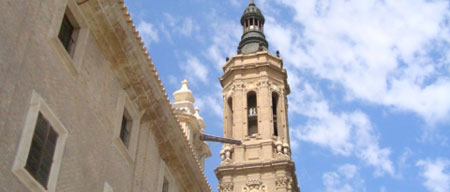Home > Study in Spain > City Guide > Zaragoza
Zaragoza City Guide
- Places of Interest
- Maps
- Getting to
- Getting around the city
As the capital city of the Zaragoza province and of the autonomous community and former Kingdom of Aragon, Spain, this gem is situated in a valley with a variety of landscapes ranging from desert to thick forest, meadows and mountains. Zaragoza is the fifth largest city in Spain and boasts a whole range of cultural amenities for visitors. As a candidate to be European Capital of Culture in 2016, this city is clearly bursting with cultural elements, vibrant visits and stunning scenery. Adding to this, the Pyrenees are a mere 2 hours away and offer the best ski resorts in Spain.
Zaragoza is famous for its folklore, a renowned local gastronomy, its landmarks and its Fiestas del Pilar which are among the most celebrated festivals in Spain. The city's weather is also a delight with temperatures soaring to the 40°C in July and August. All year round it provides pleasant temperatures for visits and this city is of particular importance as it is linked by legend to the beginnings of Christianity in Spain.
The city welcomes visitors with over 2000 years of history, shopping and sightseeing and is a clear combination of Moorish, Christian and Romanesque influences. With easy access to Madrid, Barcelona and other important cities, whether you are just passing-by or planning on staying a while, this city will not fail to disappoint.
Places of Interest
Basilica de Nuestra Señora de Pilar
This is one of the most important Marian sanctuaries in the Catholic world and is visited every year by thousands of pilgrims. It is also bursting with artistic works from various periods, in particular the frescos by Goya. Dating back to the 17th century, the Basilica is free to visit but offers entry to the tower and museum for 2€.
Palacio de la Aljafería
This is one of the most important monuments of 11th century Hispanic-Muslim architecture and despite the building's many renovations; you can take an idyllic stroll through the stunning porticos of the Santa Isabel courtyard as well as the Gilded Hall and Oratory. This Palacio has been subject to many uses through history however some of its rooms are currently used as the seat of the Aragon Parliament and the 9th century Troubadour's Tower was the setting chosen by Verdi for his famous opera Il Troubadour.
La Seo Catedral
Forming the third part of the city's trilogy of landmarks, this Mudejar-style cathedral dates back to the 12th century and its evolution with the city is clear from the interior Romanesque, Visigothic and even Baroque influences. At only 4€ it is a bargain to visit and there are even reduced tariffs for under 18s and over 65s.
Las Murallas
Dating as far back as 2-3 BC, these Roman walls contain much of Zaragoza's history and have survived through its evolution. They once had a perimeter of 3 km and the most spectacular remains of the wall on view are the San Juan de los Panetes section, in the Cesar Augosti Avenue. The wall served its purpose more during the Medieval era rather than the Roman one and was a strong vice in defending its city and deterring enemies.
El Parque Grande
Also named El Parque Primo de Rivera, this is the city's largest park enjoying 40 hectares of luscious greenery. One can enjoy its plentiful and varied spaces, such as San Sebastián avenue which is lined with an immense row of ornamental fountains. This is the ideal place to escape to to appreciate and take-in the break taking beauty of Zaragoza's nature spaces.
Loarre Castle
If you're looking to make a day trip, el Castillo de Loarre is approximately an hour from Zaragoza by car. Recently the the setting for Ridley Scott's Kingdom of Heaven, this masterpiece was constructed between the 12th-13th centuries and is one of the best Romanesque castles in Europe. Car rental is easy from Zaragoza so this is an opportunity not to be missed as it is a great chance to forget the city and venture out a little further to explain what else Spain has to offer.
Museums
Pablo Gargallo
With a number of floors, this museum comprises many artistic works corresponding to collaborations of Gargallo in architectural projects. The ground floor/mezzanine includes monumental sculptures and a cardboards hall showing the template he used to design the pieces for his metallic plate works. The first floor offers a view of the evolution of the sculptures during his life and on the second/third floor a more specific approach to his works are presented such as masks, jewellery and drawings.
La Lonja
This magnificent civil building was constructed in the mid 16th century and began being used as a gallery from the beginning of the 20th century. In 1919 the museum celebrated a Fine Arts Spanish-French exhibition which met outstanding names such as Beruete, Domingo, Picasso and Vázquez Díaz. In the 1980s it became a permanent gallery and a visit here is definitely recommended.
Juana Francés
Open for long hours during the weekdays, this gem is hidden inside the Woman House and is a space showing visual art, working from the point of view of gender. The museum's focus is on the plastic works of woman and to demonstrate their artistic quality. The museum comprises a variety of sculptures, photography, installations and new technologies.
Casa de los Morlanes
This stunning gallery is situated in the basement of a courtier-house of the 16th century and opened to the public in 1997. The museum specializes on photographic exhibitions and other disciplines related to visual arts.
Maps
Getting to Zaragoza
By Air
Zaragoza has its very own airport located only 10km from the city centre. There are a number of airlines that fly from here into Spain and Europe. There is a regular bus running into the city centre for only €1.50 however flights from Zaragoza airport can be irregular. The other option is Barcelona and Madrid airports which are both under 2 hours away with the high speed train AVE and which have a larger number of destinations at much more regular times.
By Train
Zaragoza is served by the high speed AVE which can reach both Madrid and Barcelona in less than 2 hours. There are up to 19 train a day for Madrid and 12 for Barcelona and from these large cities you can get easy connections into other Spanish or even international destinations. The Regional Express is a slow train which will take you into other neighbouring cities and is a lot cheaper.
By Bus
Zaragoza can be reached in less than 4 hours from Madrid or Barcelona and a return is approximately €26 from the coach company ALSA. There are a number of coaches well connected to other large cities such as Valencia and Bilbao and there are buses which even run to France!
Getting around the city
If you are near the old town, then it is very easy to walk around and probably the best way of taking in the stunning scenery. If you decide you want to take the bus, single tickets are 0,95€ or you can choose to purchase a card and then top it up with money. Another option is the sightseeing bus which is only €7 with the Zaragoza card and is an excellent way of seeing the sights.

